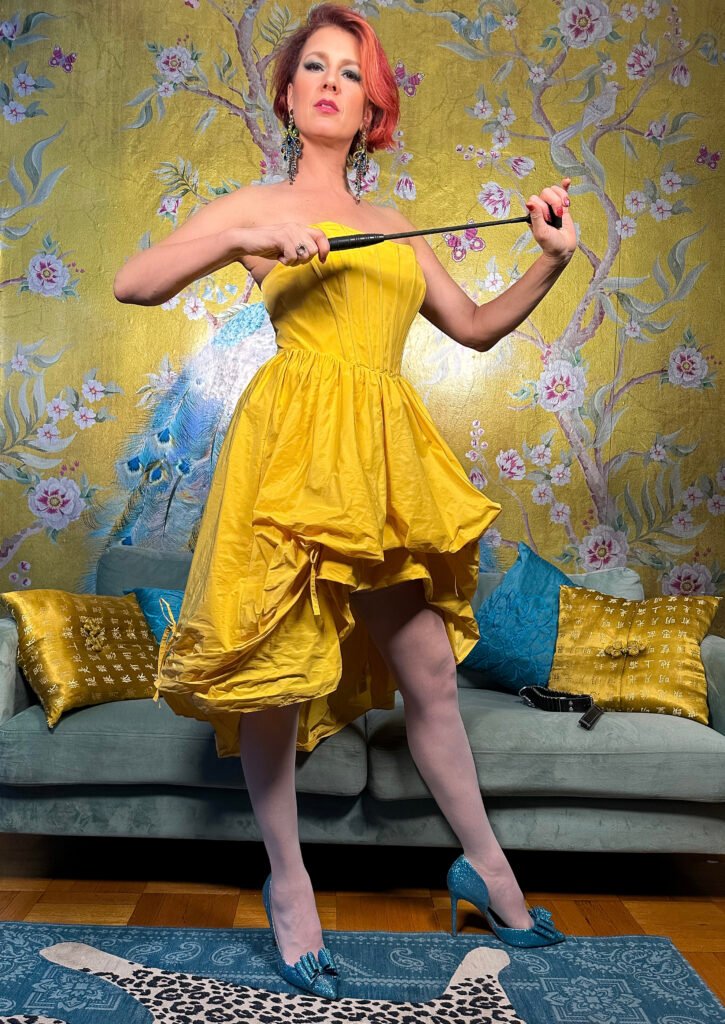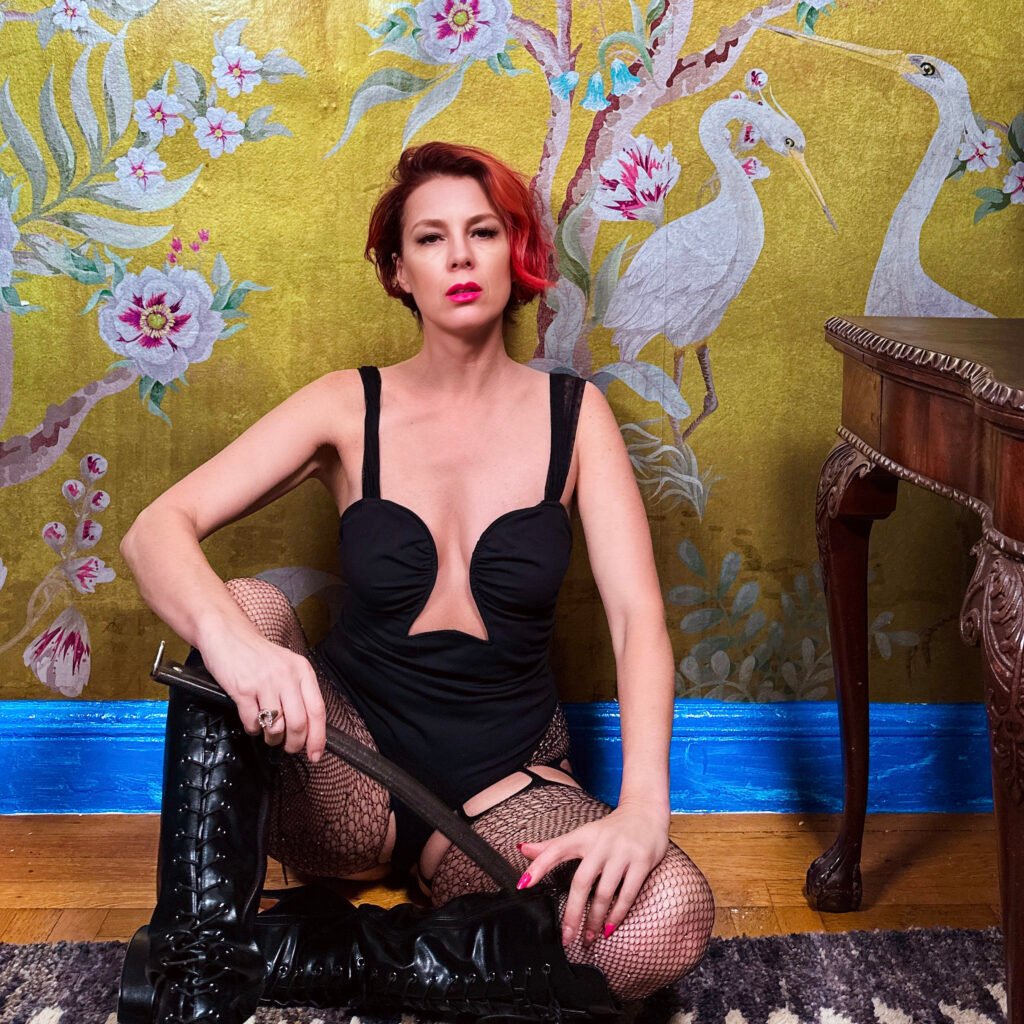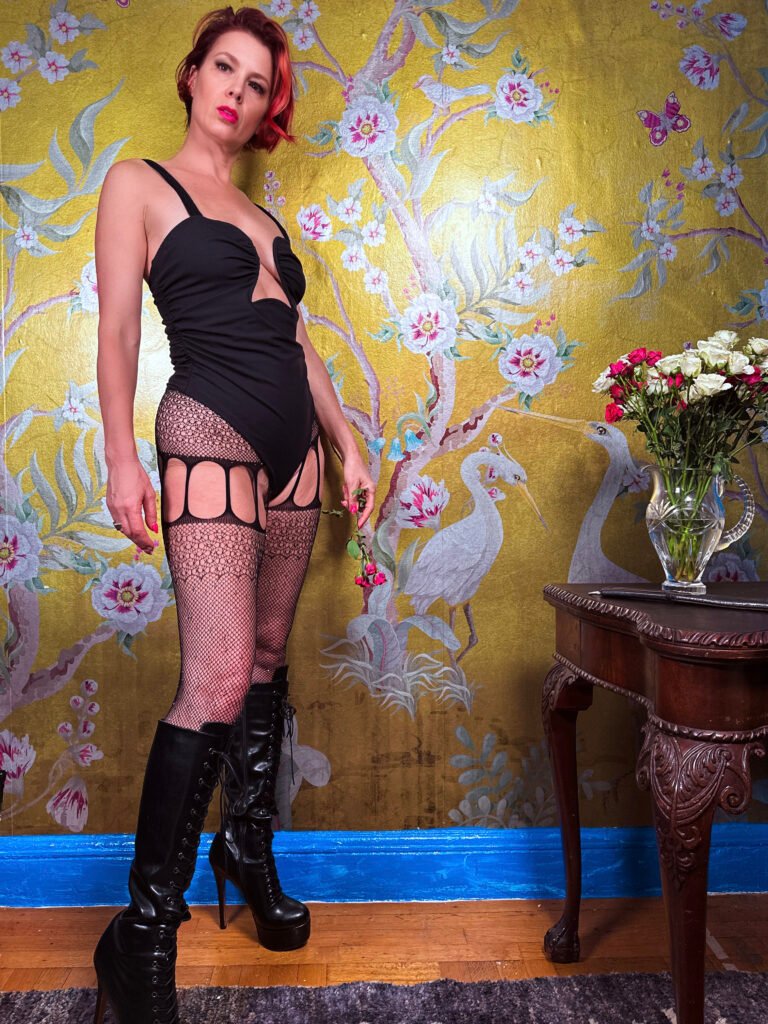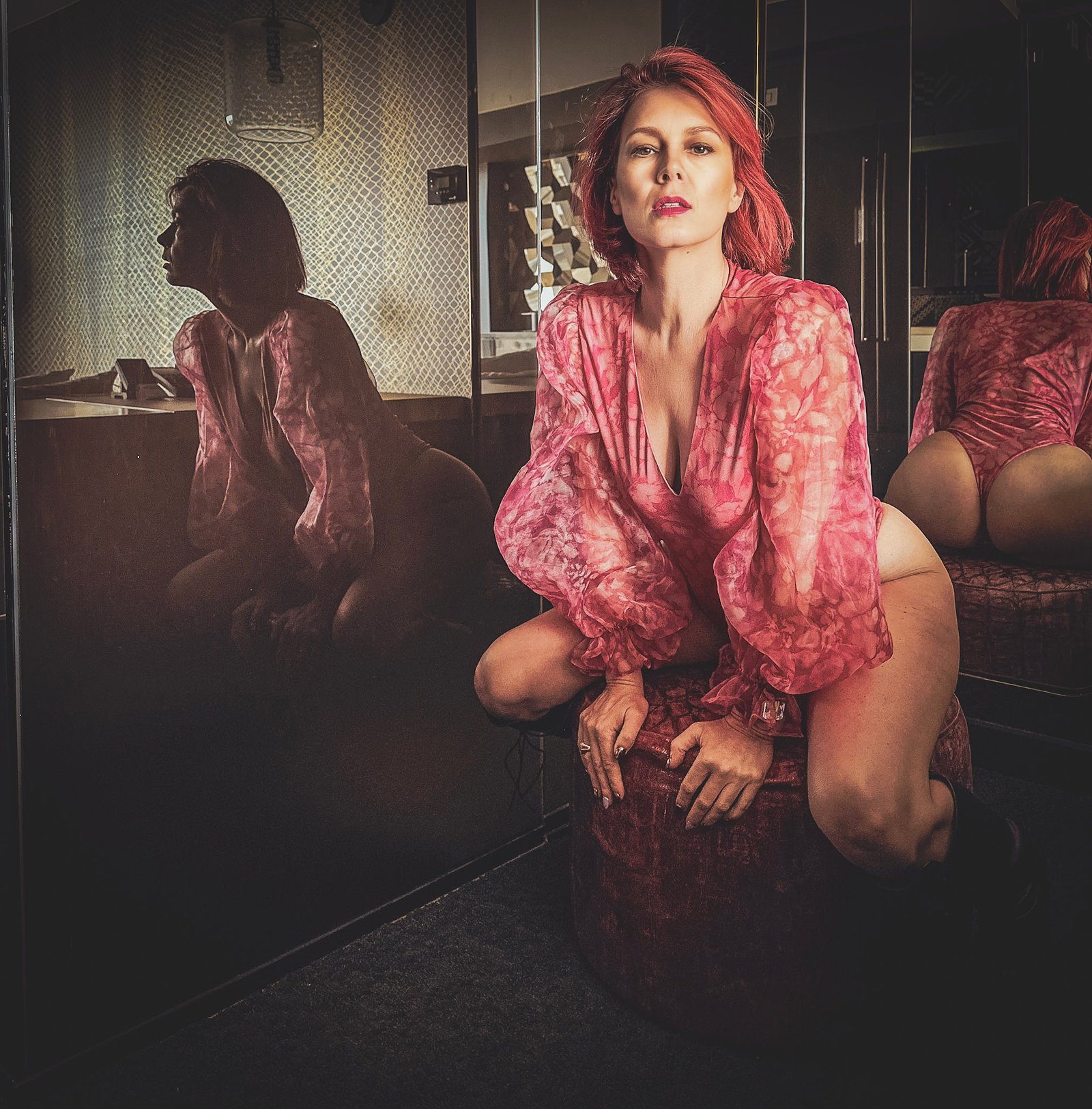Relieve boredom, anxiety, and depression through self-discovery and authentic expression; your BDSM journey may create surprise transformations, uncovering a depth beyond mere play with a professional Dominatrix.
Do you often wonder why certain aspects of FemDom excites you? Are you struggling to understand your attraction to darker scenarios? Do fleeting desires, which sometimes turn into compulsions, make you feel ashamed?
Join NYC Dominatrix and explore the allure of dominance and submission and its potential therapeutic benefits. Dive into the concept of the 'Shadow'—our hidden and suppressed selves—and 'Archetypes,' universally recognized behavior patterns, to gain deeper insight into your attractions to FemDom. Finally, discover the various FemDom archetypes and the multitude of scenarios reflecting our shadow desires.
Relieve boredom, anxiety, and depression through self-discovery and authentic expression; your BDSM journey may create surprise transformations, uncovering a depth beyond mere play with a professional Dominatrix.
Do you often wonder why certain aspects of FemDom excites you? Are you struggling to understand your attraction to darker scenarios? Do fleeting desires, which sometimes turn into compulsions, make you feel ashamed?
Join NYC Dominatrix Viktoria Sway and explore the allure of dominance and submission and its potential therapeutic benefits. Dive into the concept of the 'Shadow'—our hidden and suppressed selves—and 'Archetypes,' universally recognized behavior patterns, to gain deeper insight into your attractions to FemDom. Finally, discover the various FemDom archetypes and the multitude of scenarios reflecting our shadow desires.

The Punishing Sadistic Mistress: This FemDom archetype enjoys corporal punishment of her submissives. Tied and vulnerable, you await her switch as she doles out lashes for whatever she likes.
Understand the Appeal of FemDom and those Kinky things you secretly Crave. Explore your Desires and the Psychology Behind Them from a Dominatrixes perspective.
Goddess Viktoria Sway
1. Archetypes are universal symbols and patterns embedded in our collective unconscious—a theory proposed by the renowned Swiss psychiatrist Carl Jung. These inborn structures of the psyche silently steer our emotions, thoughts, and behaviors, often unnoticed by our conscious mind (Stein et al., 2020).
Archetypes take various shapes, from roles to characters we emulate daily. Take, for example, “The Wise Old Man” or “The Mother“. These two archetypes symbolize wisdom and nurture, respectively. They often manifest themselves through personas such as mentors and caregivers (Butler & Bowdon, 2006).
Understand the Appeal of FemDom Archetypes and those Kinky things you secretly Crave. Explore your Desires and the Psychology Behind Them from a Dominatrixes perspective.
Goddess Viktoria Sway

The Punishing Sadistic Mistress: This FemDom archetype enjoys corporal punishment of her submissives. Tied and vulnerable, you await her switch as she doles out lashes for whatever she likes.
1. Archetypes are universal symbols and patterns embedded in our collective unconscious—a theory proposed by the renowned Swiss psychiatrist Carl Jung. These inborn structures of the psyche silently steer our emotions, thoughts, and behaviors, often unnoticed by our conscious mind (Stein et al., 2020).
Archetypes take various shapes, from roles to characters we emulate daily. Take, for example, “The Wise Old Man” or “The Mother“. These two archetypes symbolize wisdom and nurture, respectively. They often manifest themselves through personas such as mentors and caregivers (Butler & Bowdon, 2006).

The Taskmaster Queen: This FemDom archetype expects perfection and diligence. That toilet better be sparkling clean!!
4. Jung proposed that archetypes are inherited brain structures passed down through generations. He suggested that these universal symbols and patterns are prevalent in our collective unconscious as they have been vicariously experienced by humanity across ages. Hence, irrespective of cultural differences or personal history, we all share a standard set of archetypes (Jung & Hull, 2014).
Jung theorized that these archetypical impulses and memories are shared human experiences attributable to the inherited brain structure. These recurring themes transcend cultural and temporal boundaries and find expression in dreams, myths, and ingrained cultural wisdom (Jung & Hull, 2014).

The Shadow Mother: This Femdom archetype mocks the arousal of her little ones, forcing masturbation and clean up under her authoritarian eye.
7. Integrating the shadow self is significant for personal growth and emotional health. As we interact with our hidden traits, we nurture self-understanding and acceptance, allowing us to confront and recognize the parts of us that usually go unnoticed (Jung, 2014). Subsequently, the process cultivates emotional intelligence, aiding us in comprehending and managing our feelings more effectively.
Shadow integration is also essential in establishing deeper, genuine connections with others by promoting honesty and authenticity. Integration supports individuals in releasing societal norms and discovering their true longings, thereby improving authenticity and overall wellness (Fahkry, 2017).

The Slave Driver Sadistic Mistress: Pushing you to your limits; the nipple clamps tighten if your plank position falters and your ass feels the strap for failing.
9. The shadow voice, also known as the dark or hidden side of our psyche, is a crucial aspect of Jung’s theory of archetypes. It represents the parts of ourselves that we reject, repress, or deny because they do not align with our conscious identity (Abrams & Zweig, 1991). These rejected aspects can stem from societal norms, personal experiences, or even inherited traits from our ancestors (Jung and Hull, 2014).
10. By pushing these elements into the unconscious, we often become unaware of how they influence our behaviors, emotions, and perceptions. The Shadow contains negative traits, such as anger and envy, and potentially positive qualities, like creativity and intuition, that have all been suppressed
(Abrams & Zweig, 1991).
11. Engaging with the Shadow through archetypal work involves bringing these hidden elements into consciousness, allowing for a more integrated and authentic self (Abrams & Zweig, 1991).
This process, known as shadow integration, helps individuals confront and accept their darker aspects, fostering increased self-awareness and emotional intelligence(Abrams & Zweig, 1991).
Jungian analysts argue that facing the Shadow is essential for achieving individuation, the process of becoming whole and fully realizing one’s potential (Perry et al., 2023).

2. Furthermore, archetypes can find their way into our dreams and fantasies (Stein et al., 2020). They act as symbolic mirrors, reflecting our subconscious desires and conflicts. For instance, dreaming of being a hero could indicate our inner quest for courage and the drive to tackle life’s challenges.
2. Furthermore, archetypes can find their way into our dreams and fantasies (Stein et al., 2020). They act as symbolic mirrors, reflecting our subconscious desires and conflicts. For instance, dreaming of being a hero could indicate our inner quest for courage and the drive to tackle life’s challenges
3. Understanding archetypes can give us insights into our subconscious, helping us better understand ourselves and our actions (Jones, 2017).
Identifying the archetypes we naturally resonate with can, more importantly, pave the way toward a balanced, integrated personality and stimulate personal growth. Additionally, this insight aids in fostering empathy and comprehending others’ motivations as they might relate to different archetypes.

The Divine Ruler Goddess: This FemDom archetype expects unwavering devotion. At her feet, devotees are granted the honor of worshiping every toe with their tongue.
4. Jung proposed that archetypes are inherited brain structures passed down through generations. He suggested that these universal symbols and patterns are prevalent in our collective unconscious as they have been vicariously experienced by humanity across ages. Hence, irrespective of cultural differences or personal history, we all share a standard set of archetypes (Jung & Hull, 2014).
Jung theorized that these archetypical impulses and memories are shared human experiences attributable to the inherited brain structure. These recurring themes transcend cultural and temporal boundaries and find expression in dreams, myths, and ingrained cultural wisdom (Jung & Hull, 2014).
5. Psychologist Carl Jung first introduced the concept of the Shadow. Much research and many books have been written covering this topic. Below, you will find a list of resources I encourage you to explore for further information.
6. Our Shadow refers to the unconscious aspect of our personality, consisting of repressed thoughts, feelings, and behaviors that we deem unacceptable or undesirable (Perry et al., 2023.). These hidden aspects of ourselves often hold deep emotional wounds and unresolved issues from our past and childhood, which creates feelings of isolation and loneliness (Roush et al., 2017). They may also include traits we have been taught are “wrong” or go against societal norms. However, Jung believed acknowledging and integrating these shadow aspects is essential for personal growth and individuation.

The Goddess Muse: This FemDom archetype serves as a source of inspiration and creativity. Her submissives find new ways earn her favor, offering unsolicited days of chastity in her honor.
7. Integrating the shadow self is significant for personal growth and emotional health. As we interact with our hidden traits, we nurture self-understanding and acceptance, allowing us to confront and recognize the parts of us that usually go unnoticed (Jung, 2014). Subsequently, the process cultivates emotional intelligence, aiding us in comprehending and managing our feelings more effectively.
Shadow integration is also essential in establishing deeper, genuine connections with others by promoting honesty and authenticity. Integration supports individuals in releasing societal norms and discovering their true longings, thereby improving authenticity and overall wellness (Fahkry, 2017).
8. Shadow integration entails becoming aware of our embarrassments and incorporating this understanding into our consciousness. Such awareness can substantially mitigate mental health issues like anxiety and depression as we learn to accept and deal with our weaknesses and fears rather than avoiding and repressing them. Significant research demonstrates the negative impact on our bodies these anxieties can cause, including high blood pressure, obesity, and even heart disease (Sapolsky, 2004).
Shadow integration is essential for mental health improvement, personal progression, and enhanced relationships.

The Disciplinarian Queen: This FemDom archetype rules and reprimands with precision and sternness. Failure to keep 2 feet behind her while leashed earns 20 lashes.
12. Furthermore, integrating the Shadow can lead to healthier relationships and improved mental well-being, as it encourages sincerity and authenticity in interactions with others (Abrams & Zweig, 1991) by embracing the full spectrum of our inner world. When our true desires are rooted outside of societal norms, growth, healing and enhanced well-being are fostered.
9. The Shadow archetype, also known as the dark or hidden side of our psyche, is a crucial aspect of Jung’s theory of archetypes. It represents the parts of ourselves that we reject, repress, or deny because they do not align with our conscious identity (Abrams & Zweig, 1991). These rejected aspects can stem from societal norms, personal experiences, or even inherited traits from our ancestors (Jung and Hull, 2014). By pushing these elements into the unconscious, we often become unaware of how they influence our behaviors, emotions, and perceptions. The Shadow contains negative traits, such as anger and envy, and potentially positive qualities, like creativity and intuition, that have all been suppressed
(Abrams & Zweig, 1991).
10. By pushing these elements into the unconscious, we often become unaware of how they influence our behaviors, emotions, and perceptions. The Shadow contains negative traits, such as anger and envy, and potentially positive qualities, like creativity and intuition, that have all been suppressed
(Abrams & Zweig, 1991).
11. Engaging with the Shadow through archetypal work involves bringing these hidden elements into consciousness, allowing for a more integrated and authentic self (Abrams & Zweig, 1991).
This process, known as shadow integration, helps individuals confront and accept their darker aspects, fostering increased self-awareness and emotional intelligence(Abrams & Zweig, 1991).
Jungian analysts argue that facing the Shadow is essential for achieving individuation, the process of becoming whole and fully realizing one’s potential (Perry et al., 2023).
12. Furthermore, integrating the Shadow can lead to healthier relationships and improved mental well-being, as it encourages sincerity and authenticity in interactions with others (Abrams & Zweig, 1991) by embracing the full spectrum of our inner world. When our true desires are rooted outside of societal norms, growth, healing and enhanced well-being are fostered.

The Amazon Warrior Enforcer: Your ego is crushed by the physical presence of my 6'6" stature in heels. Your body crushed as I use my ass to pin you down.
15. For the Dominant, embodying roles such as the Sadistic Mistress or Shadow Queen enables the expression of control, authority, and even cruelty in a controlled manner. This exploration can lead to a deeper understanding of these traits and how they influence one’s behavior and relationships outside of the BDSM dynamic.
For the submissive, BDSM offers a space to relinquish control and experience vulnerability, which can be both frightening and liberating. Submissives might confront their fear of helplessness or their desire for punishment and degradation, thereby gaining insight into their motivations and emotional needs. The consensual nature of BDSM ensures that all interactions are negotiated and agreed upon, providing a safe container for this intense psychological exploration.
13. Shadow psychology, rooted in Jung’s theories, refers to exploring and integrating the darker, often unconscious aspects of one’s personality. As discussed previously, these shadow elements include repressed desires, fears, and traits that one might find socially unacceptable or uncomfortable. In the context of BDSM dynamics, the interplay between shadow psychology and power exchange relationships can create a profound and transformative experience for those involved.
14. BDSM provides a structured environment where individuals can safely explore their shadow aspects. Dominants and submissives engage in consensual power exchanges that allow them to confront and express elements of their psyche that are typically hidden or suppressed.

The Enchantress Temptress: This FemDom archetype presents seductive challenges to her submissives. Forbidden to move she brushes her beautiful breasts against you, staring into your eyes as you yearn for her touch.
15. For the Dominant, embodying roles such as the Sadistic Mistress or Shadow Queen enables the expression of control, authority, and even cruelty in a controlled manner. This exploration can lead to a deeper understanding of these traits and how they influence one’s behavior and relationships outside of the BDSM dynamic.
For the submissive, BDSM offers a space to relinquish control and experience vulnerability, which can be both frightening and liberating. Submissives might confront their fear of helplessness or their desire for punishment and degradation, thereby gaining insight into their motivations and emotional needs. The consensual nature of BDSM ensures that all interactions are negotiated and agreed upon, providing a safe container for this intense psychological exploration.
16. The rituals and protocols within BDSM can serve as therapeutic tools to facilitate the integration of shadow elements. For example, punishment and reward can help individuals understand their internalized beliefs about discipline and self-worth. Roleplaying scenarios can allow participants to act out and process complex emotions in a supportive setting.
Through these practices, both Dominants and submissives can achieve a greater sense of self-awareness and personal growth.
Now, after I have filled you in on some psychology concepts and how they connect to BDSM,…the fun part. Why am I attracted to some kinky shit! Let us discuss some common FemDom archetypes and how they relate to shadowplay.
17. Exploring Dominatrix archetypes through play, such as creative expression or roleplaying, allows us to experiment safely with different aspects of our psyche. Play provides a non-threatening environment to explore power dynamics, authority, and other elements associated with these archetypes. This exploration can be both liberating and therapeutic. Studies have shown that “BDSM practitioners were less neurotic, more extraverted, more open to new experiences, more conscientious, less rejection sensitive, and had higher subjective well-being.” (Wismeijer & van Assen, 2013)
18. In the realm of FemDom, several archetypes emerge that parallel traditional Jungian archetypes, each encapsulating unique aspects of female dominance and power. These archetypes provide frameworks for understanding the psychological dynamics at play and offer a structured way to explore and express complex facets of the psyche.
Each archetype has many roles that may be played to explore different shadow feelings within players. The roles may repeat across some archetypes but will have a different tone and explore a unique feeling.

The Nurturing Matriarch Teacher: This FemDom archetype educates her submissive, giving JOI instructions while she stands over them to correct technique.
As you explore the below Archetypes you may find scenarios that resonate with a part of you. It’s essential to keep in mind that playing in these areas does not mean that this is who you are. Play is an aspect of your person, and the more you know and integrate it, the more control you have over your everyday behavior choices. If one plays with these dark desires, they have less of an unconscious influence on our daily lives.
You may wonder which I enjoy now that you have read about all the possibilities. I am not much for scripted roleplays. Still, I enjoy weaving many of these qualities into my play- expanding my everyday personality to embody my shadow characteristics. Follow the links to each archive and see the roles I particularly relish. You will find a * marking the roles of my shadow voice. You may notice that I have not selected much in the Nurturing Matriarch. This is my predominant natural personality; thus, it does not fall under my Shadow.
Integrating FemDom archetypes and our shadow voices is a powerful path toward authenticity and mental well-being. Acknowledging and accepting all parts of ourselves can reduce internal conflict, enhance personal growth, and foster a more profound sense of self. If you’re ready to explore these aspects of your psyche, consider contacting a professional for guidance and support.
Remember, the journey to self-discovery is ongoing. We can achieve greater harmony and fulfillment by continually engaging with our Shadow and integrating its lessons.


December Special: Feel the strong pull of FemDom in your Entire Being
A rare opportunity to play with me at a discounted rate as I fine-tune sessions designed to amplify masculine presence, polarity, confidence, focus, and erotic power.
Choose your activity:
Sensation Play – awaken every nerve
Edging – push limits, surrender control
Verbal Altered States – let words guide your mind and surrender
Impact Play – channel intensity, build resilience
Predicament Play – challenge yourself, strengthen discipline
💥 Level 1: 1 Hour – $300
📍 Manhattan only and on Select Tours as time allows.
⚡ Only 5 sessions available scheduled before December 30th—spots will fill fast.
Claim yours before they’re gone.
